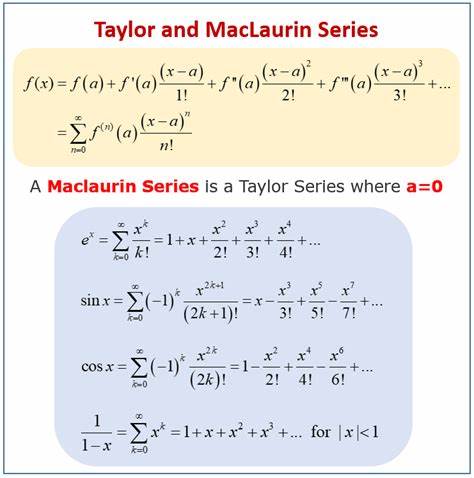SciTech-Mathmatics-Taylor Equation泰勒公式: 用幂级数(幂函数的和) 去无穷拟合 N阶可导函数(连续可导有N阶导数)
https://www.mathsisfun.com/algebra/taylor-series.html
https://math.libretexts.org/Bookshelves/Calculus/Calculus_3e_(Apex)/08%3A_Sequences_and_Series/8.08%3A_Taylor_Series

Derivative and Slope
Quick review: a \(derivative\) gives us the \(\text{slope of a function}\) at \(any\ point\).
These derivative rules can help us:
- The derivative of \(a\ constant\) is 0
- The derivative of \(a x\) is \(a\) (example: the derivative of \(2x\) is \(2\))
- The derivative of \(x^n\) is \(nx^{n-1}\) (example: \(\text{the derivative of }x^3\text{ is }3x^2\))
- We will use the little mark \(’\) to denote "\(\text{derivative of}\)" (example: \(f'(x)\) denote the \(\text{derivative of } f(x)\)).
Taylor Series:
-
\(\large \text{First define } f^{(0)} (x) = f(x) \text{ and } 0! = 1\) :
-
Formula:
\(\large \begin{array}{rll} \\ f(x) &=& \sum_{n=0}^{\infty}{\frac{f^{(n)}(x_0)}{n!} (x-x_0)^n} \\ &=& f(x_0) +\sum_{n=1}^{\infty}{\frac{f^{(n)}(x_0)}{n!} (x-x_0)^n} \\ \end{array}\) -
Examples:
\(\begin{array}{rll} \\ e^x &=& \sum_{n=0}^{\infty} {\frac{x^n}{n!}} \\ &=& 1 + x + \frac{x^2}{2!} + \frac{x^3}{3!} + \frac{x^4}{4!} + \frac{x^5}{5!} + \cdots + \frac{x^n}{n!} \\ \cos (x) &=& \sum_{n=0}^{\infty} {\frac{(-1)^{(n)}}{(2n)!} {x^{(2n)}} } \\ &=& 1 + \frac{(-1)x^{2}}{2!} + \frac{(+1)x^{4}}{4!} + \cdots + \frac{(-1)^{(n)}}{(2n)!} {x^{(2n)}} \\ \sin (x) &=& \sum_{n=0}^{\infty} {\frac{(-1)^{n}}{(2n+1)!} {x^{(2n+1)}} } \\ &=& x + \frac{(-1)x^{3}}{3!} + \frac{(+1)x^{5}}{5!} + \cdots + \frac{(-1)^{n}}{(2n+1)!} {x^{(2n+1)}} \\ \end{array}\)
Let $\large \ x=i \cdot y $ and \(\large i^2=-1\):
\(\begin{array}{rll} \\ e^x = e^{i \cdot y} &=& \sum_{n=0}^{\infty} {\frac{(i \cdot y)^n}{n!}} \\ &=& 1 + i \cdot y + \frac{-1 \cdot y^2}{2!} + i \cdot \frac{-1 \cdot y^3}{3!} + \frac{+1 \cdot y^4}{4!} + i \cdot \frac{+1 \cdot y^5}{5!} + \cdots + i^{n} \cdot \frac{(y^n}{n!} \\ &=& (1 + \frac{-1 \cdot y^2}{2!} + \frac{+1 \cdot y^4}{4!} + \cdots ) + i ( y + \frac{-1 \cdot y^3}{3!} + \frac{+1 \cdot y^5}{5!} + \cdots ) \\ &=& \cos y + i \sin y \\ \therefore e^{ix} &=& \cos x + i \sin x\ , \text{ Euler's Equation} \\ \end{array}\)
So \(the\ Taylor's\ Equation,\ Euler's\ Equation \text{ are unified in }Complex\ Space\) with $ the\ Trigonometry\ Functions and \(\ Natural\ Exponential\ Functions\) -
Applications of Taylor Series
The uses of the Taylor series are:- Taylor series is used to evaluate the value of a whole function in each point,
if the functional values and derivatives are identified at a single point. - The representation of Taylor series reduces many mathematical proofs.
The sum of partial series can be used as an approximation of the whole series. - Multivariate Taylor series is used in many optimization techniques.
This series is used in the power flow analysis of electrical power systems.
- Taylor series is used to evaluate the value of a whole function in each point,
Maclaurin Series:
- \(\text{First define } f^{(0)} (x) = f(x) \text{ and } 0! = 1\) :
- Formula: \(\begin{array}{ccc} \\ f(x) &=& \sum_{n=0}^{\infty}{\frac{f^{(n)}(x_0)}{n!} (x-x_0)^n} \\ &=& f(0) +\sum_{n=1}^{\infty}{\frac{f^{(n)}(0)}{n!} x^n} \\ \\ \end{array}\)
幂级数拟合:
幂函数: \(\large x^n\ ,\ n \in N\ ,\ x \in R\) 这类函数, 例如 \(x^2\ ,\ x^3\ ,\ ...\)
其优点:
- 容易计算及实现:
计算上, 只要对 x 及系数\((+\ ,\ -\ ,\ \times\ ,\ \div)\)就可快速高性能求值; 甚至 口/心/笔 算可得出结果;
实现上, 对硬件没特别要求, 嵌入式设备上都可快速实现, 并已有许多可直接使用的成熟软硬件库); - 任意拟合精度: 预先确定可拟合至任意精度, 并可根据需要设置:
- 幂函数的特点(properties)为人熟知使用:
例如:
\(y = a \cdot x^2 + bx + c\) 的 U形图, 有极值以及求解极值.
\(y = a \cdot x^3 + b x^2 + c x + d\) 的 两个极值以及求解极值 .
...
Taylor Series幂级数(Taylor Series)证明
\(\text{First define } f^{(0)} (x) = f(x) \text{ and } 0! = 1\) :
\(\begin{array}{lll} \\
\text{hypothesis: } \\
\text{ 1. the function } f(x) \text{ has }derivatives\ of\ \ every\ order \text{ and that we can in fact find them all. } \\
\text{ 2. the function } f(x) \text{ does in fact have }a\ power\ series\ \text{representation about } x=x_0\ . \end{array}\)
\(\begin{array}{rll} \\ \text{such that:} & \\ \exists\ f(x) &= P(x)\ ,\ \forall\ f(x) \\ \text{where}\ P(x) &= \sum_{n=0}^{\infty}{c_{n}(x-x_0)^n} \\ &= c_{0}(x-x_0)^0 + c_{1}(x-x_0)^1 + c_{2}(x-x_0)^2 + ... + c_{n}(x-x_0)^n +\ ... \\ &= c_{0} + \sum_{n=1}^{\infty}{ c_{n}(x-x_0)^n} \\ \ c_0 &= f(x_0) \\ P^{(0)}(x) &= f^{(0)}(x) \\ P^{(1)}(x) &= f^{(1)}(x) \\ P^{(2)}(x) &= f^{(2)}(x) \\ P^{(3)}(x) &= f^{(3)}(x) \\ & ... \\ P^{(n)}(x) &= f^{(n)}(x) \\ \end{array}\)
\(\begin{array}{rll} \\ P^{(0)}(x) &=& c_{0} &+& c_{1}(x-x_0)^1 &+& c_{2}(x-x_0)^2 &+& c_{3} (x-x_0)^{3} &+&\ ... &+& c_{n}(x-x_0)^n &+&\ ... \\ P^{(1)}(x) &=& 0 &+& 1! c_{1} &+& 2! c_{2} (x-x_0)^1 &+& 3 c_{3} (x-x_0)^{(3-1)} &+&\ ...\ &+& n c_{n}(x-x_0)^{(n-1)} &+&\ ... \\ P^{(2)}(x) &=& 0 &+& 0 &+& 2! c_{2} &+& 3! c_{3} (x-x_0)^{(3-2)} &+&\ ...\ &+& n(n-1) c_{n}(x-x_0)^{(n-2)} &+&\ ... \\ P^{(3)}(x) &=& 0 &+& 0 &+& 0 &+& 3! c_{3} &+&\ ...\ &+& n(n-1)(n-2) c_{n}(x-x_0)^{(n-3)} &+&\ ... \\ &...& \\ P^{(n)}(x) &=& 0 &+& 0 &+& 0 &+& 0 &+&\ ...\ &+& n! c_{n} &+&\ ... \\ &...& \\ \text{NOW plugin in } x &=& x_0 \text{ , and we have: } & & \\ P^{(0)}(x_0) &=& f^{(0)}(x_0) = 0!c_{0} & & \\ P^{(1)}(x_0) &=& f^{(1)}(x_0) = 1!c_{1} & & \\ P^{(2)}(x_0) &=& f^{(2)}(x_0) = 2!c_{2} & & \\ P^{(3)}(x_0) &=& f^{(3)}(x_0) = 3!c_{3} & & \\ &...& & & \\ P^{(n)}(x_0) &=& f^{(n)}(x_0) = n!c_{n} & & \\ &...& & & \\ \\ c_{n} &=& \frac{f^{(n)}(x_0)}{n!} \\ \\ \end{array}\)
\(\begin{array}{lll} \\ \text{coefficients} & \\ & where & c_{n}=\frac{f^{(n)}(x_0)}{n!} \\ \\ \end{array}\)
\(\text{First define } f^{(0)} (x) = f(x) \text{ and } 0! = 1\) :
\(\begin{array}{ccc} \\
f(x) &=& \sum_{n=0}^{\infty}{\frac{f^{(n)}(x_0)}{n!} (x-x_0)^n} \\
\\ \end{array}\)
Frequently Asked Questions – FAQs
- Q1 What is a Taylor series?
Taylor series is a function of an infinite sum of terms in increasing order of degree. Taylor series of polynomial functions is a polynomial. - Q2 What is the use of Taylor series?
Taylor series is used to evaluate the value of a whole function in each point if the functional values and derivatives are identified at a single point. - Q3 What is a Maclaurin series?
A Taylor series is called Maclaurin series when the function is centered at zero point.



 浙公网安备 33010602011771号
浙公网安备 33010602011771号